Sinkiang Province, Republic of China
| Sinkiang Province 新疆省 | |||||
| | |||||
| |||||
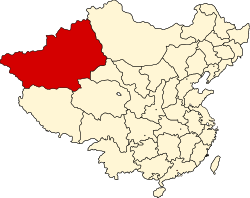 | |||||
| Capital | |||||
| Historical era | 20th Century | ||||
| • | Established | 1912 | |||
| • | Surrender to the People's Liberation Army | 13 October 1949 | |||
| • | Dissolution of the Sinkiang Provincial Government Office | 16 January 1992 | |||
| Area | |||||
| • | 1928 | 1,711,931 km2 (660,980 sq mi) | |||
| Population | |||||
| • | 1928 | 2,550,000 | |||
| Density | 1.5 /km2 (3.9 /sq mi) | ||||
| Today part of | |||||
Sinkiang (Chinese: 新疆省; pinyin: Xīnjiāng shěng; or Xinjiang) refers to a former province of the Republic of China. First set up in 1884 as a province of the Qing Dynasty, it was replaced in 1955 by the Xinjiang Uyghur Autonomous Region of the People's Republic of China. The original provincial government was relocated to Taipei as the Sinkiang Provincial Government Office (新疆省政府辦事處) until its dissolution in 1992.
Administration
The province inherited the borders of the Qing Dynasty province, bordering Kansu, Tsinghai, the Mongol Area, Tibet Area, and the countries Soviet Union, Afghanistan, Pakistan, and India. The claimed boundaries of the province included all of today's Xinjiang and parts of Mongolia, Tajikistan, Afghanistan, and Pakistan.[1] The province had an area of 1,711,931 km2.
History
In 1912, the Qing dynasty was replaced by the Republic of China. Yuan Dahua, the last Qing governor of Xinjiang, fled. One of his subordinates, Yang Zengxin, took control of the province and acceded in name to the Republic of China in March of the same year. Through Machiavellian politics and clever balancing of mixed ethnic constituencies, Yang maintained control over Xinjiang until his assassination in 1928 after the Northern Expedition of the Kuomintang.[2]
The Kumul Rebellion and other rebellions arose against his successor Jin Shuren in the early 1930s throughout Xinjiang, involving Uyghurs, other Turkic groups, and Hui (Muslim) Chinese. Jin drafted White Russians to crush the revolt. In the Kashgar region on November 12, 1933, the short-lived self-proclaimed First East Turkistan Republic was declared.[3][4] The Hui Kuomintang 36th Division (National Revolutionary Army) destroyed the army of the First East Turkestan Republic at the Battle of Kashgar (1934), bringing the Republic to an end. The Soviet Union invaded the province in the Soviet Invasion of Xinjiang. In the Xinjiang War (1937), the entire province was brought under the control of northeast Manchu warlord Sheng Shicai, who ruled Xinjiang for the next decade with close support from the Soviet Union. In 1944, the President and Premier of China, Chiang Kai-shek, informed by the Soviets of Sheng's intention to join the Soviet Union, decided to shift him out of Xinjiang to Chongqing as the Minister of Agriculture and Forest.[5] More than a decade of Sheng's era had ended. However, a short-lived Soviet-backed Second East Turkestan Republic was established in that year, which lasted until 1949 in what is now Ili Kazakh Autonomous Prefecture (Ili, Tarbagatay and Altay Districts) in northern Xinjiang.
During the Ili Rebellion the Soviet Union backed Uyghur separatists to form the Second East Turkistan Republic (2nd ETR) in Ili region while the majority of Xinjiang was under Republic of China Kuomintang control.[3] The People's Liberation Army entered Xinjiang in 1949 and the Kuomintang commander Tao Zhiyue surrendered the province to them.[4] The original provincial government was relocated to Taipei as the Sinkiang Provincial Government Office (新疆省政府辦事處) to symbolize the ROC's claim of sovereignty over the province; it was eventually dissolved in 1992.
Demographics
The population of Sinkiang was about 2.55 million (1928, Ministry of the Interior). About 70% of the population was Uyghur while less than 10% was Han Chinese.
List of governors
Non-partisan/ unknown Warlords Communist Party of the Soviet Union Kuomintang (Nationalist)
Chairperson of the Provincial Government (Nationalist Government)
| No. | Portrait | Name (Birth–death) |
Term of office | Political Party | |
|---|---|---|---|---|---|
| 1 |  |
Yang Zengxin 楊增新 Yáng Zēngxīn (1864–1928) |
1912 | 7 July 1928 | Xinjiang clique |
| Assassinated. | |||||
| 2 |  |
Jin Shuren 金樹仁 Jīn Shùrén (1879–1941) |
7 July 1928 | April 1933 | Xinjiang clique |
| Deposed in coup. | |||||
| 3 | Liu Wenlong 劉文龍 Liú Wénlóng (1870–1950) |
August 1933 | December 1933 | ||
| Removed from office and placed under house arrest by Sheng Shicai. | |||||
| 4 | Zhu Ruichi 朱瑞墀 Zhū Ruìchí (1862–1934) |
December 1933 | 5 March 1934 | ||
| Died in office. | |||||
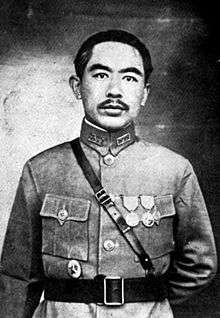 |
Sheng Shicai 盛世才 Shèng Shìcái (1897–1970) |
5 March 1934 | 29 August 1944 | Military | |
| 5 | Communist Party of the Soviet Union | ||||
| Kuomintang | |||||
| Removed from office. | |||||
| 6 | 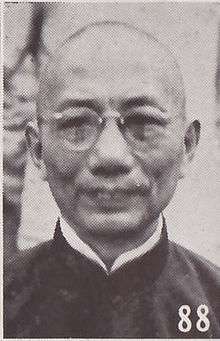 |
Wu Zhongxin 吳忠信 Wú Zhōngxìn (1884–1959) |
29 August 1944 | March 1946 | Kuomintang |
| Resigned. | |||||
| 7 | 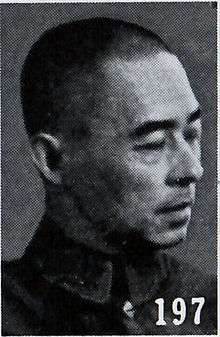 |
Zhang Zhizhong 張治中U+200E Zhāng Zhìzhōng (1895–1969) |
March 1946 | June 1947 | Kuomintang |
| Removed from office. | |||||
| 8 | 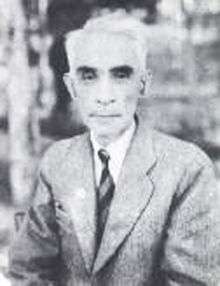 |
Masud Sabri 麥斯武德 مەسئۇت سابرى U+200E (1887–1952) |
June 1947 | January 1949 | Kuomintang |
| 9 | Burhan Shahidi 包爾漢 بۇرھان شەھىدى U+200E (1894–1989) |
January 1949 | 26 September 1949 | Kuomintang | |
| Surrendered to the People's Liberation Army. | |||||
Sinkiang Provincial Government Office era
Chairperson of the Provincial Government
| No. | Portrait | Name (Birth–death) |
Term of office | Political party | |
|---|---|---|---|---|---|
| 1 | 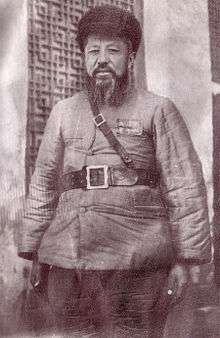 |
Yulbars Khan 堯樂博士 بيۇلبارس خان U+200E (1888–1971) |
11 April 1950 | 27 July 1971 | Kuomintang |
| Died in office. | |||||
Director, Sinkiang Provincial Government Office
| No. | Portrait | Name (Birth–death) |
Term of office | Political party | |
|---|---|---|---|---|---|
| 1 | Yao Tao-hung 堯道宏 Yáo Dàohóng |
27 July 1971 | ? | Kuomintang | |
| Son of Yulbars Khan. | |||||
| 2 | Hou Chi-yu 侯紀峪 Hóu Jìyù |
? | 16 January 1992 | Kuomintang | |
| Post abolished. | |||||
References
- ↑ ROC Administrative and Claims.jpg. Wikipedia. Map showing the claims of the ROC.
- ↑ Governors of Xinjiang: Yang Zengxin (1912–1928), Jin Shuren (1928–33), Sheng Shicai (1933–44); source: "Xinjiang". Encyclopædia Britannica Online. Encyclopædia Britannica Inc. 2016. Retrieved June 19, 2016.
- 1 2 Feener, R. Michael (2004). Islam in World Cultures: Comparative Perspectives. Religion in Contemporary Cultures. Santa Barbara, Calif.: ABC-CLIO. p. 174. ISBN 1-57607-516-8. OCLC 940831123.
- 1 2 Bhattacharji, Preeti (May 29, 2012). "Uighurs and China's Xinjiang Region". Council on Foreign Relations. Retrieved June 19, 2016.
- ↑ Brown, Jeremy (2010). Dilemmas of Victory: The Early Years of the People's Republic of China. Cambridge, Mass.: Harvard University Press. p. 186. ISBN 9780674033658. OCLC 822561761.